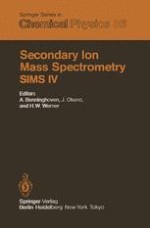1984 | OriginalPaper | Buchkapitel
Quantitative Depth Profiling of B and P in Borophosphosilicate Glass
verfasst von : P. K. Chu
Erschienen in: Secondary Ion Mass Spectrometry SIMS IV
Verlag: Springer Berlin Heidelberg
Enthalten in: Professional Book Archive
Aktivieren Sie unsere intelligente Suche, um passende Fachinhalte oder Patente zu finden.
Wählen Sie Textabschnitte aus um mit Künstlicher Intelligenz passenden Patente zu finden. powered by
Markieren Sie Textabschnitte, um KI-gestützt weitere passende Inhalte zu finden. powered by
Borophosphosilicate glass (BPSG) is used in the semiconductor industry for two purposes: (1) as a top passivation layer on electronic devices and (2) as an intermetal dielectric (typically between aluminum and polysilicon) [1,2]. The advantages of BPSG over undoped Si02 is its ability to reflow within device-compatible temperature ranges [3,4] and its formation of better aluminum contact step coverage [5]. In addition, the presence of phosphorus in the passivation layer serves to getter impurities and minimizes the penetration of alkali metals into the device [6]. Although these advantages are significant, the high P concentration in BPSG, coupled with its high porosity and hygroscopicity (related to P contents), is a major cause of corrosion of aluminum runs in devices [7,8]. As a consequence, it is necessary to have a thin phosphorus free glass layer between the BPSG and A1.
